Keras
National Hazard
   
Posts: 896
Registered: 20-8-2018
Location: (48, 2)
Member Is Offline
|
|
Potassium permanganate from manganese dioxide, potassium hydroxide and potassium chlorate (as oxidising agent).
First of all, allowance must be paid to the purity of the starting materials. Manganese dioxide from batteries is often not pure and seem to contain
carbon powder (used to improve conductivity). I’ve not tested pyrolusite (though I’ve ordered some, and I plan to use it in a future batch – so
rather: I’ve not tested pyrolusite yet). The best bet so far is to recycle the manganese dioxide obtained during the synthesis process together with
the permanganate. The product thus obtained is very pure, fine and has a very large surface/volume ratio apparently, which makes it ideal for further
transformation.
The potassium chlorate I used was made from boiling 9.6% NaClO bleach, metathesis with KCl and recrystallisation. It was also quite pure (see
picture).
Chemplayer has a video on KMnO₄ synthesis from MnO₂ but frankly, they got all wrong. I’m not sure what kind of dioxide they started from
(probably battery grade). Using potassium nitrate is a very bad idea, because not only nitrate is much weaker oxidiser than potassium chlorate
(nitrate has only one oxygen atom to lose, chlorate has three), but also because I suspect that the nitrite thus formed is partly re-oxidised to
nitrate by the permanganate, lowering the yield, whereas KCl doesn’t react with permanganate. Finally, using sodium bicarbonate as an acidifying
agent to foster the disproportionation is the final straw: as they themselves admit, the final result is a mix of various potassium and sodium salts
from which permanganate is all but impossible to isolate. It’s like cooking a soup by mixing various boiled vegetables and then try to salvage one
of them from the brew. The Wiki part of Sciencemadness should stop mentioning this totally inefficient method. Besides, the Chemplayer guys
were unduly optimistic in eyeballing their yield. Permanganate solutions are very deep in colour, less than a single milligram dropped in 100 ml of
water will dissolve into an almost blackish solution. IMHO, they obtained at most a few tens of milligrams, which would make any cristallisation a pie
in the sky.
To begin with, 40 g of KOH and 15 g of KClO₃ are mixed together, placed in a steel pot and moderately heated on a burner until they’ve melted.
Manganese dioxide (mine was blended from the dried-up recycling of a previous batch and from fresh battery scavenging) is added in small portions (4
or 5 additions) with stirring in between. At first the mix remains fairly fluid, but the last addition gives rise to a very thick paste, blackish in
colour, with superficial patches of green due to the formation of manganate by surface oxidation with air (this is the industrial process). After the
last addition the burner is pushed to full thrust.
A couple of minutes later the real reaction kicks off. A part of the melt heats suddenly up to a red glow, and this is accompanied by a distinctive
hissing sound (see picture). This is probably caused by potassium chlorate turning to potassium chloride and releasing its oxygen. The paste
ressembles lava, glowing inside with a black superficial crust. The reaction travels from one end to the other, advancing through the paste at slow
speed, with a distinct heat frontline along which one can see some tiny white frothing (oxygen bubbles, probably). I’ve no idea if the incandescence
is a normal phenomenon, caused by the exothermicity of the oxidation from Mn(IV) to Mn(VI), or if it is caused by the carbon being oxidised to carbon
dioxide (which would bubble out and cause the hissing). In any case the heat released ensures the completion of the reaction. It is over as soon as
the hissing sound subsides and the glow disappears.
If this incandescence does not happen, it’s either because you don’t have heated the paste enough, or because your starting materials are too
impure. In either case, you will only get surface oxidation, and the yield will be measly.
The steel pot is left to cool, and meanwhile 500 ml of water are brought to a boil in a 600 ml beaker. Once the paste has cooled down, it is broken
into chunks using whatever handy method (I used awl and hammer), and the lumps are dropped in the boiling water. Immediately, the water turns an
opaque pink. It *never* turns green, the colour of manganate, because the disproportionation into permanganate and manganese dioxide is
instantaneous at low pH. If you obtain a green solution, that means you have much unreacted potassium hydroxide, and your yield will be low to null.
That being said, the disproportionation also recreates potassium hydroxide, so the pH rises until the manganate ends up persisting. After twenty
minutes or so (the paste dissolves rather slowly), the beaker is full of a sort of dirty pink solution and much manganese dioxide has fallen at the
bottom. The manganese dioxide is filtered out and put aside to dry for a future batch (prime starting material), the filtrate is returned to the
beaker and further boiled.
At that point, a carbon dioxide generator is setup using w/e method seems fit. I used 23% HCl dripped over sodium bicarbonate, but in hindsight I
would probably recommend mixing bicarbonate with a solid acid such as tartaric, citric or sulphamic acid and dripping water. The reaction with HCl is
barely manageable, produces big bubble bursts and the resulting table salt, which is insoluble in concentrated hydrochloric acid, tends to cover the
bicarbonate and quenches the reaction (use stirring). This is not really efficient, but hopefully both bicarbonate and hydrochloric acid are cheap and
OTC.
The carbon dioxide thus made is bubbled into the boiling solution of manganate/permanganate which progressively turns more and more purple. It is
stopped when the pH reaches 9 (this can be tricky to estimate, as pH paper is stained and probably degraded by the permanganate), at which point the
disproportionation can be held as complete.
The contents of the beaker are filtered again to remove any freshly produced manganese dioxide (only a very thin layer is collected at this stage, I
discarded it), and the clarified solution is left to boil until the level has reached about 150 ml (see picture). It is then cooled and placed in the
fridge, then in the freezer. Upon cooling, dark, pure needles of potassium permanganate precipitate out, and those are collected on a Büchner funnel
(see picture).
To be continued (yield and other considerations).
[Edited on 30-5-2023 by Keras]
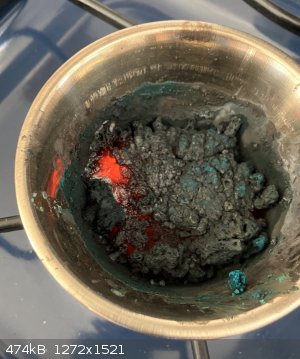 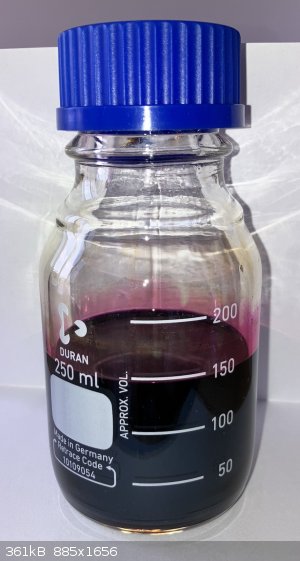 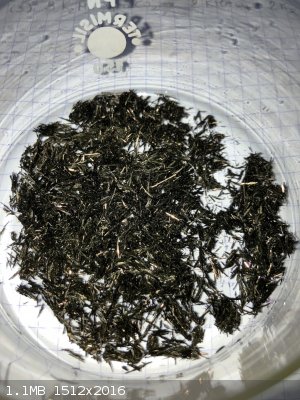 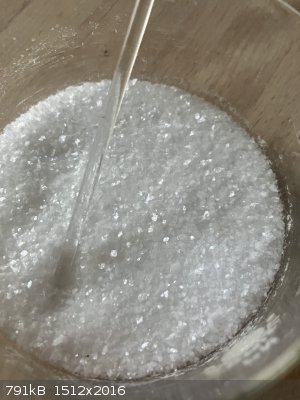
|
|
|
woelen
Super Administrator
        
Posts: 8012
Registered: 20-8-2005
Location: Netherlands
Member Is Offline
Mood: interested
|
|
Very good write-up. You started from very mundane reagents, even the KClO3 is made from simple reagents available around the house! Well done.
It is good to see people making basic reagents like KMnO4, which are harder to obtain every year.
The color of the crystals you get is quite similar to the color of some commercial sample I have. It has a greenish lustre, which disappears
immediately, when a drop of water is added to the solid. Of course, it is not possible to assess the purity of the isolated product, but its
appearance is a good indication.
|
|
|
Fery
International Hazard
    
Posts: 1015
Registered: 27-8-2019
Location: Czechoslovakia
Member Is Offline
|
|
Hi Keras, well done and perfectly detailed description! Observing that pyro-lava effect must be amazing experience! As woelen wrote, your crystals
look perfect and good quality.
Did you use sintered glass for the filtrations? What did you use for cleaning the sinter (e.g. oxalic acid or sodium bisulfite)?
How stable is KMnO4 in boiling water solution? How fast does its solution decompose when heated over 80 C? And especially with traces of MnO2. You
seem to filter the solution very thoroughly. When the disproportionation reaction manganate + CO2 -> permanganate there is MnO2 as a byproduct and
you kept T on boiling.
Here an article about its stability in water solution but only at room temperature. They claim that pure solution (without MnO2) is quite stable, they
titrated its solutions in 1981 and 1983 with no significant differences in concentrations:
https://sci-hub.wf/10.1021/ed064p1058
Attachment: ed064p1058.pdf (758kB)
This file has been downloaded 287 times
Which sorcery trick did you use for measuring pH? As you wrote, permanganate overcolors any pH paper and oxidizes the paper as well indicator. Boiling
solution probably not good for digital pH meter - did you take a little of the solution, cooled down, measured with pH meter, returned back?
|
|
|
Rainwater
National Hazard
   
Posts: 919
Registered: 22-12-2021
Member Is Offline
Mood: indisposition to activity
|
|
Just thinking outloud
$$3MnO_2 + KClO_3 + 6KOH \rightarrow 3K_2MnO_4 + KCl + 3H_2O$$
ΔH 904.8327 kJ/mol
ΔS 388.5842 J mol/K
T=2329 K
ΔG -0.1799 kJ/mol
But thats maths wrong because I do not have values for those reagents in a molten state..the entropy would increasing lowering the reaction
temperature.
I want to see me some lava. Adding this to my ToDo list. Looking foward to your yields
"You can't do that" - challenge accepted
|
|
|
Keras
National Hazard
   
Posts: 896
Registered: 20-8-2018
Location: (48, 2)
Member Is Offline
|
|
Quote: Originally posted by woelen  |
Very good write-up. You started from very mundane reagents, even the KClO3 is made from simple reagents available around the house! Well done.
It is good to see people making basic reagents like KMnO4, which are harder to obtain every year.
The color of the crystals you get is quite similar to the color of some commercial sample I have. It has a greenish lustre, which disappears
immediately, when a drop of water is added to the solid. Of course, it is not possible to assess the purity of the isolated product, but its
appearance is a good indication. |
Thanks a bunch for that! Coming from you, I’m honoured. However, I’m not to be credited with the procedure. I simply followed the recipe detailed
in Inorganic Preparations; A Laboratory Manual by H. F. Walton (1948). I washed the crystals twice with 10 ml of icy water. IMHO, they’re
pretty pure. It’s difficult to assess their purity using the melting point test, though.
The only semi-OTC component was potassium hydroxide, which is fairly easily findable, though 9.6% bleach might be difficult to source. It is much more
handy to work with than standard 2.7% one (albeit there is a lot of salt to slog with). I had the chance to locate a big hardware store selling
concentrated bleach by tanks of 20 L, so I pounced on one of them. I also bought a 20 L tank of distilled water. It’s cheaper in those quantities
than small 1 l bottles.
Some of the potassium chlorate I made by directly bubbling chloride into a hot (~ 85 °C) solution of potassium hydroxide (chloride from HCl and
TCCA). The co-produced KCl I used to convert sodium chlorate into potassium chlorate.
At the moment, I’m trying to figure out if I could squeeze more permanganate by boiling to solution further. I have collected about 3 g of crystals,
which is really poor (10% yield, see below). Freezing the solution further produced more crystals. I could see them shine in the bottle when I took it
out of the freezer, but they disappeared during the filtration. It’s a bit frustrating.
The procedure calls for stopping the evaporation when the solution reaches 150 ml. I suppose that’s based on the assumption of a much better yield.
The dioxide I used as a starting material was partly derived from batteries, and that was not ideal. I’m waiting for pyrolusite to arrive and will
try another batch with it.
Anyways, I’m a bit at a loss when it comes to compute the theoretical yield. The oxidation reaction must go like this:
(1) 3 MnO₂ + 6 KOH + KClO₃ → 3 K₂MnO₄ + 3 H₂O + KCl (water might be responsible for the hissing sound)
Afterwards, the disproportionation can occur under two different mechanisms:
(2) 3 K₂MnO₄ + 2 H₂O → 2 KMnO₄ + MnO₂ + 4 KOH
(3) 3 K₂MnO₄ + 2 CO₂ → 2 KMnO₄ + 2 K₂CO₃ + MnO₂
Of course, we also have: 2KOH + CO₂ → K₂CO₃ + H₂O
So the yield of permanganate is at most ⅔ of the yield of manganate. If this is the case, given how much MnO₂ I collected back, a *lot* of it must
have failed to react initially, wherefore my initial remark on the necessity of having very pure reagents, and a very fine powder, because the
oxidation won’t proceed inside even little chunks.
I think I can evaporate the solution down to 100 ml and get more product. Here is my line of reasoning:
The respective starting materials are KOH, 713 mmol, KClO₃, 122 mmol and MnO₂, 287 mmol. A quick look at (1) shows that both potassium hydroxide
and chloride are in excess w/r to manganese dioxide in the initial mix.
Given that I already collected around 3 g of crystals, and that the 150 ml show no sign of precipitation at 25 °C, the maximum weight of permanganate
contained in those 150 ml is 1.5 times the solubility of KMnO₄ per 100 ml at 25 °C, or 11.4 g. In total, the reaction could have produced 11.4 + 3
= 14.4 g of permanganate, i.e. circa half the theoretical yield (191 mmol, or 30 g), which wouldn't be bad but is obviously not the case. Up to now, I
collected only 3 g, or 19 mmol, that is about 10% of this.
Assuming that all the potassium chlorate is turned into potassium chloride, that gives us 122 mmol of KCl, or 9 g, which, given that the solubility of
KCl at 0 °C is 27.8 g / 100 mL, means it won’t crystallise even if the solution is reduced to 50 mL.
The other co-product is potassium carbonate, which I will assume has been produced from potassium hydroxide in a 100% yield, i.e. 713 mmol. That would
be 98 g of K₂CO₃, which, given its solubility at 0 °C, would require about 100 ml of water to be kept dissolved. I can therefore boil another 50
ml of solution down and probably still crystallise pure permanganate crystals.
[Edited on 30-5-2023 by Keras]
|
|
|
Keras
National Hazard
   
Posts: 896
Registered: 20-8-2018
Location: (48, 2)
Member Is Offline
|
|
Quote: Originally posted by Fery  | Hi Keras, well done and perfectly detailed description! Observing that pyro-lava effect must be amazing experience! As woelen wrote, your crystals
look perfect and good quality.
Did you use sintered glass for the filtrations? What did you use for cleaning the sinter (e.g. oxalic acid or sodium bisulfite)?
How stable is KMnO4 in boiling water solution? How fast does its solution decompose when heated over 80 C? And especially with traces of MnO2. You
seem to filter the solution very thoroughly. When the disproportionation reaction manganate + CO2 -> permanganate there is MnO2 as a byproduct and
you kept T on boiling.
Here an article about its stability in water solution but only at room temperature. They claim that pure solution (without MnO2) is quite stable, they
titrated its solutions in 1981 and 1983 with no significant differences in concentrations:
https://sci-hub.wf/10.1021/ed064p1058
Which sorcery trick did you use for measuring pH? As you wrote, permanganate overcolors any pH paper and oxidizes the paper as well indicator. Boiling
solution probably not good for digital pH meter - did you take a little of the solution, cooled down, measured with pH meter, returned back?
|
Thanks! 
Filtration was carried out using sintered glass, yes. Cleaning the filter is easy with 23% HCl. HCl converts manganese dioxide to manganese (II)
chloride, which is water soluble. The brown spots disappear in seconds. That’s how I cleaned my fingers, too. 
Much to my surprise, potassium permanganate seems to be quite stable even at 100 °C. I was expecting a lot of decomposition to happen, but it seems
fairly stable. That might be caused by the slightly alcaline pH. As soon as water disappears, though, the permanganate reverts to manganese dioxide,
as the brown streaks on the wall of the beaker prove.
The disproportionation caused by the bubbling of carbon dioxide was very limited. I collected probably just a few milligrams of additional manganese
dioxide during the subsequent filtration. Most of the disproportionation happened initially when the ‘lava rock’ was transferred into the hot
boiling water. That is why the solute never turned green but immediately pinkish.
I’m going to bed right now, but I will post follow-ups tomorrow!
Oh and, for the pH, I was able to spot a fine line of unmarred pH paper just on the edge of the purple permanganate spot!
[Edited on 30-5-2023 by Keras]
|
|
|
Keras
National Hazard
   
Posts: 896
Registered: 20-8-2018
Location: (48, 2)
Member Is Offline
|
|
Quote: Originally posted by woelen  | | Of course, it is not possible to assess the purity of the isolated product, but its appearance is a good indication. |
I’m going to use iodometric titration to assess the purity of the crystals. 20 mg dissolved in an excess of KI, then reduction with a standard
solution of sodium thiosulphate.
[Edited on 31-5-2023 by Keras]
|
|
|
Keras
National Hazard
   
Posts: 896
Registered: 20-8-2018
Location: (48, 2)
Member Is Offline
|
|
Addendum: I tried to squeeze out some more crystals from what was left of the ‘mother liquor’ after the first cooling and crystallisation, but it
was a big dud. Slow evaporation at 65 °C to circa 100 ml and then cooling to almost 0°C in freezer gave rise to extensive decomposition, the result
being a slurry of manganese dioxide and probably a mix of Mn VI and II in solution. The liquid turned from pink/purple to something like dark red,
which could be also MnO₂ colour mixed with MnO₄⁻. In any case, nothing usable was collected on to the Büchner funnel. I discarded everything.
Next batch I’ll start from 1. scavenged manganese dioxide from my two previous attempts; 2. fresh commercial grade pyrolusite.
We’ll see. Meanwhile, I have to make more potassium chlorate, so back to boiling bleach. :p
|
|
|
RU_KLO
Hazard to Others
  
Posts: 209
Registered: 12-10-2022
Location: Argentina
Member Is Offline
|
|
In order to squish more product, maybe adding a Potassium salt could get you more cristals?(common-ion effect)
[Edited on 6-6-2023 by RU_KLO]
[Edited on 6-6-2023 by RU_KLO]
Go SAFE, because stupidity and bad Luck exist.
|
|
|
Keras
National Hazard
   
Posts: 896
Registered: 20-8-2018
Location: (48, 2)
Member Is Offline
|
|
Quote: Originally posted by RU_KLO  | | In order to squish more product, maybe adding a Potassium salt could get you more cristals?(common-ion effect) |
This is theoretically a good idea, but the solution already contains a lot of potassium chloride (from potassium chlorate) and potassium carbonate
(from potassium hydroxide and carbon dioxide) so… I doubt I can squeeze much more permanganate this way! :p
|
|
|
Aqua-regia
Hazard to Others
  
Posts: 126
Registered: 18-12-2006
Member Is Offline
Mood: No Mood
|
|
It is exist cheaper methode: If you have ball mill, you can working in molten KOH some water with superfine MnO2 with good stirring, and bubbling
into suspension oxigen. (dry aer oxigen also working) Th reaction temp. cca 180 degrees celsius, treatment with oxygen costs 10-12 hours. After this,
ordinary cooling and filter the unreacted MnO2 and completed the manganate oxidation with chlorine bubbling to get permanganate. Yield 60-80 %,
depends of particle size of MnO2.
2MnO2 + 4KOH +O2 ——> 2K2MnO4 +2 H2O
2K2MnO4 + Cl2 ——> 2KCl +2KMnO4
The potassium permanganate isolation is easy peasy, cause KCl ten more better dissolving in water than KMnO4.
0 oC 10 oC
KCl 28,00 31,20
KMnO4 2,8 4,81
ref:
https://en.wikipedia.org/wiki/Potassium_permanganate
PatentGB292991 (A) - Process for the manufacture of potassium manganate
[Edited on 7-6-2023 by Aqua-regia]
|
|
|
Keras
National Hazard
   
Posts: 896
Registered: 20-8-2018
Location: (48, 2)
Member Is Offline
|
|
Quote: Originally posted by Aqua-regia  | | It is exist cheaper methode: If you have ball mill, you can working in molten KOH some water with superfine MnO2 with good stirring, and bubbling
into suspension oxigen. |
Yeah, I’m well aware that oxygen alone suffices to drive Mn (IV) to Mn (VI). However, as you point out, this requires superfine dioxide, and
furthermore, you can't scoop it into molten potassium hydroxide, because the mix is much too thick. You get only surface oxidation of the paste, and
that leads to a miserable yield. I know, I've tried it, hoping it would make for an easier separation. (Unless you’re prepared to spend the whole
day kneading your paste.)
The industrial process has this superfine powder wrapped into molten potassium hydroxide and it is pulverised into a large room where the dust falls,
allowing oxygen to react, before being collected at the bottom.
So you’re right, potassium permanganate is easy to extract by crystallisation, provided you achieve a high enough yield, so there is anything to
crystallise at all.
|
|
|
Aqua-regia
Hazard to Others
  
Posts: 126
Registered: 18-12-2006
Member Is Offline
Mood: No Mood
|
|
Here is my earlier synthesis description, with some foto and results:
Place a 1000 ml three-necked flask equipped with a gas inlet tube with a large stirrer and a long air cooler in a heating mantle and measure in 800 g
of KOH and 105 g of water using a plastic funnel. Turn on the heat and melt the lye to make it mixable. Sprinkle 150 g (1.2M) of very fine MnO2 [1],
preferably pulverized in a ball mill, into the molten KOH while constantly stirring. Oxygen (or, failing that, carbon dioxide-free compressed air) is
fed into the hot suspension for 10 hours. The temperature is kept between 170-180 oC.
Carefully pour 800 ml of water into the hot melt in small portions and pour it into a larger beaker and cool it to freezing point and keep it there
for a few hours. Filter the unreacted MnO2 from the cold solution using a Buchner funnel, but use double filter paper. Thoroughly stir the well-sucked
solid residue in a little hot water and filter again. Dry the unreacted MnO2 in an oven and measure it again.
The clean, filtered alkaline manganate solution is poured into a two- or three-necked flask equipped with a gas inlet tube. Connect the other neck of
the flask with 2 gas washing bottles. The first one is installed upside down, and a dilute NaOH solution is poured into the second one. Introduce
chlorine gas [2] into the manganate solution until the air space of the empty gas washing bottle turns pale yellow from the chlorine.
The raw potassium permanganate is recrystallized from hot water and additional crystals are obtained by evaporating it once from the mother liquor.
The salt is sucked off well, washed with a little ice water and dried in a desiccator.
Remarks:
[1] The efficiency of exploration and extraction depends largely on the crushing of manganese dioxide. Pulverization of commercially available MnO2 in
a mortar gives only 30-40% extraction, while grinding with a ball mill results in much more extraction.
[2] Chlorine is developed using the usual trichloroisocyanuric acid method, with sulfuric acid drying
Theoretical bacground and Results:
In an alkaline medium, manganese dioxide is converted to manganate with an oxidizing agent, which can be further oxidized to permanganate:
2MnO2 + 4KOH +O2 ——> 2K2MnO4 +2 H2O
2K2MnO4 + Cl2 ——> 2KCl +2KMnO4
It can be seen from the solubility table below (g/100 g of water) that the solubility of potassium permanganate at low temperatures is about ten times
lower than that of potassium chloride, so fractional crystallization and recrystallization lead to a pure product.
0oC 10oC 10oC 10oC 40oC 50oC 60oC
KCl 28.00 31.20 34.20 37.20 40.10 42.60 45.80
KMnO4 2.83 4.81 6.34 9.03 12.6 16.9 22.1
During the process, for the first time I did not use a ball mill, I started with 70% MnO2. Of the 150 g, 50.60 g reacted, the rest remained unchanged.
(48%). After 72 hours of grinding with the same ball mill, 108.0 g was recovered.
The extracted potassium permanganate recrystallized (ball mill method): 61.49 g.
Theoretical yield: 0.547 M (86.58 g), practical yield: 71% based on the MnO2 wich reacted.
|
|
|
Aqua-regia
Hazard to Others
  
Posts: 126
Registered: 18-12-2006
Member Is Offline
Mood: No Mood
|
|
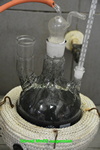
[Edited on 7-6-2023 by Aqua-regia]
|
|
|
Aqua-regia
Hazard to Others
  
Posts: 126
Registered: 18-12-2006
Member Is Offline
Mood: No Mood
|
|
molten KOH
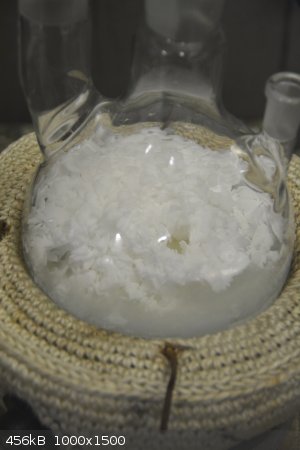
|
|
|
Aqua-regia
Hazard to Others
  
Posts: 126
Registered: 18-12-2006
Member Is Offline
Mood: No Mood
|
|
fine suspension of Mno2
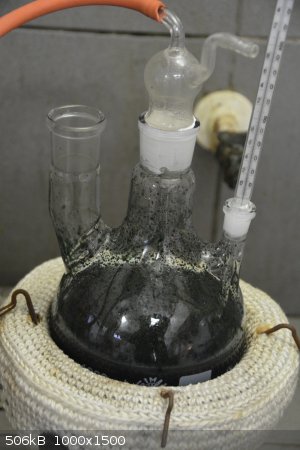
|
|
|
Aqua-regia
Hazard to Others
  
Posts: 126
Registered: 18-12-2006
Member Is Offline
Mood: No Mood
|
|
appearance of green manganate
[Edited on 7-6-2023 by Aqua-regia]
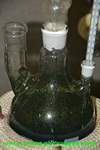
|
|
|
Aqua-regia
Hazard to Others
  
Posts: 126
Registered: 18-12-2006
Member Is Offline
Mood: No Mood
|
|
chlorinating process
[Edited on 7-6-2023 by Aqua-regia]
Attachment: phpjMwl1x (322kB)
This file has been downloaded 173 times
|
|
|
Aqua-regia
Hazard to Others
  
Posts: 126
Registered: 18-12-2006
Member Is Offline
Mood: No Mood
|
|
cristallising KMnO4
Attachment: phpbboGqv (442kB)
This file has been downloaded 173 times
|
|
|
Keras
National Hazard
   
Posts: 896
Registered: 20-8-2018
Location: (48, 2)
Member Is Offline
|
|
Lol, I don’t want to rain on your parade, but really I wonder how your flask survived molten KOH…
Otherwise nice, though I'd rather avoid working with elemental chlorine (but I accept this is not that obnoxious).
|
|
|
|